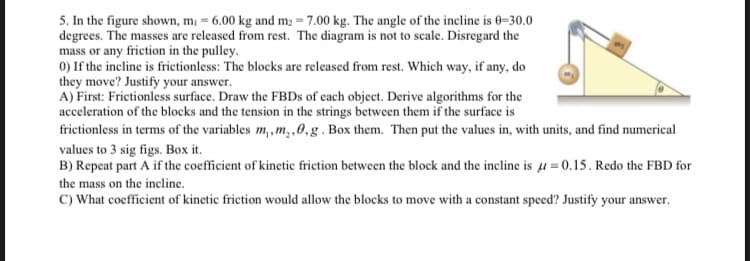5. In the figure shown, m = 6.00 kg and m2 = 7.00 kg. The angle of the incline is 0-30.0 degrees. The masses are released from rest. The diagram is not to scale. Disregard the mass or any friction in the pulley. 0) If the incline is frictionless: The blocks are released from rest. Which way, if any, do they move? Justify your answer. A) First: Frictionless surface. Draw the FBDS of each object. Derive algorithms for the acceleration of the blocks and the tension in the strings between them if the surface is frictionless in terms of the variables m, m,,0,g. Box them. Then put the values in, with units, and find numerical values to 3 sig figs. Box it. B) Repeat part A if the coefficient of kinetic friction between the block and the incline is = 0.15. Redo the FBD for the mass on the incline. C) What coefficient of kinetic friction would allow the blocks to move with a constant speed? Justify your answer.
5. In the figure shown, m = 6.00 kg and m2 = 7.00 kg. The angle of the incline is 0-30.0 degrees. The masses are released from rest. The diagram is not to scale. Disregard the mass or any friction in the pulley. 0) If the incline is frictionless: The blocks are released from rest. Which way, if any, do they move? Justify your answer. A) First: Frictionless surface. Draw the FBDS of each object. Derive algorithms for the acceleration of the blocks and the tension in the strings between them if the surface is frictionless in terms of the variables m, m,,0,g. Box them. Then put the values in, with units, and find numerical values to 3 sig figs. Box it. B) Repeat part A if the coefficient of kinetic friction between the block and the incline is = 0.15. Redo the FBD for the mass on the incline. C) What coefficient of kinetic friction would allow the blocks to move with a constant speed? Justify your answer.
College Physics
1st Edition
ISBN:9781938168000
Author:Paul Peter Urone, Roger Hinrichs
Publisher:Paul Peter Urone, Roger Hinrichs
Chapter9: Statics And Torque
Section: Chapter Questions
Problem 24PE: If you used an ideal pulley of the type shown in Figure 9.26(a) to support a car engine of mass 115...
Related questions
Question
100%
I’m stuck on this problem. Thanks

Transcribed Image Text:5. In the figure shown, mị = 6.00 kg and m2 = 7.00 kg. The angle of the incline is 0=30.0
degrees. The masses are released from rest. The diagram is not to scale. Disregard the
mass or any friction in the pulley.
0) If the incline is frictionless: The blocks are released from rest. Which way, if any, do
they move? Justify your answer.
A) First: Frictionless surface. Draw the FBDS of each object. Derive algorithms for the
acceleration of the blocks and the tension in the strings between them if the surface is
frictionless in terms of the variables m, ,m,,0,g. Box them. Then put the values in, with units, and find numerical
values to 3 sig figs. Box it.
B) Repeat part A if the coefficient of kinetic friction between the block and the incline is µ = 0.15. Redo the FBD for
the mass on the incline.
C) What coefficient of kinetic friction would allow the blocks to move with a constant speed? Justify your answer.
Expert Solution
This question has been solved!
Explore an expertly crafted, step-by-step solution for a thorough understanding of key concepts.
This is a popular solution!
Trending now
This is a popular solution!
Step by step
Solved in 2 steps with 2 images

Knowledge Booster
Learn more about
Need a deep-dive on the concept behind this application? Look no further. Learn more about this topic, physics and related others by exploring similar questions and additional content below.Recommended textbooks for you

College Physics
Physics
ISBN:
9781938168000
Author:
Paul Peter Urone, Roger Hinrichs
Publisher:
OpenStax College

College Physics
Physics
ISBN:
9781938168000
Author:
Paul Peter Urone, Roger Hinrichs
Publisher:
OpenStax College